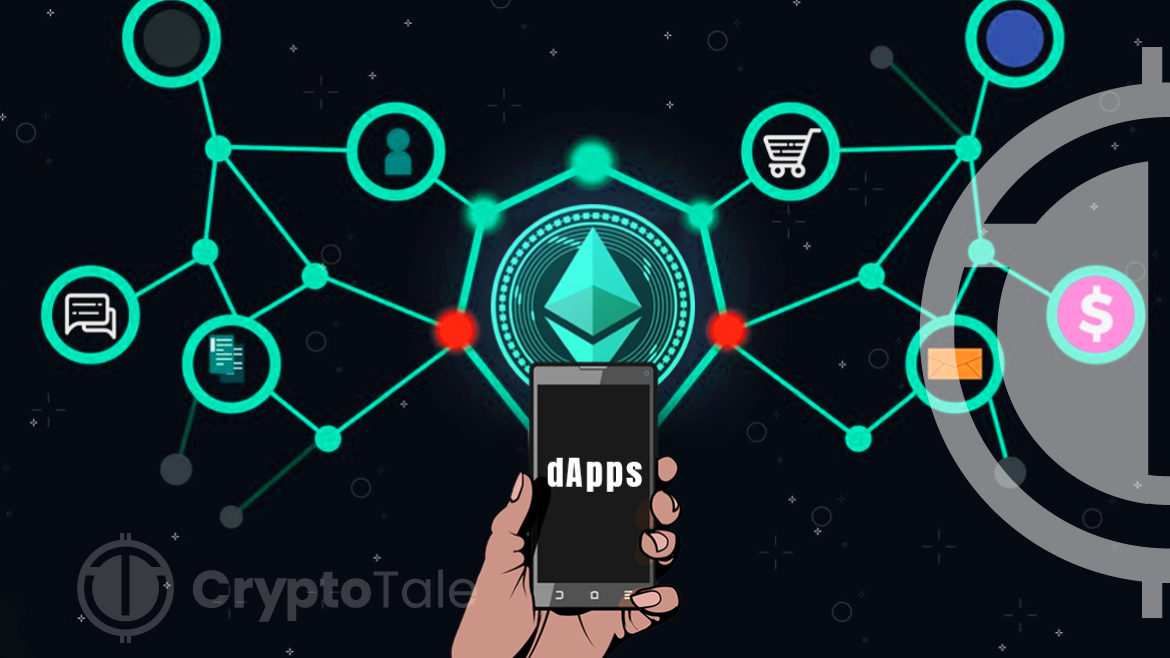
dApps or decentralized applications operate on a network of computers connected to the blockchain instead of a single central computer. It is a new avenue in the blockchain space that can be used to improve many of the traditional industries like finance, games, entertainment, and more.
What are Decentralized Applications (dApps)?
Decentralized applications, or dApps, are distributed, open-source software applications that run on peer-to-peer blockchain networks. dApps are different from other software applications, where they operate across the nodes of a blockchain instead of being isolated inside a central server. dApps are mostly based on the Ethereum platform.
dApps are not controlled by a single individual or an entity because of the decentralized nature of blockchain. The distributed ledger technology and consensus mechanism ensure that no central authority can gain control over the dApp.
For instance, take a social media app where you can post anything, but if the post is in violation of any guidelines or other reasons, the company can easily delete your post. But if the app were a dApp, no one would be able to delete the post, even the app creators. Because in a dApp the creator or users can have complete ownership of the content they create.
Certain criteria must be met before being classified as a dApp. They are:
1. Decentralization: The application data and transactions should be distributed across the network of nodes on the blockchain to avoid centralized control.
2. Open Source: The codebase of an application should be freely accessible to all so that it can be modified by the community. Any changes to the app’s structure should only be done with the support of the majority.
3. Protocol: dApps need certain protocols to measure the proof of value. This ensures consistency and security throughout the blockchain.
4. Tokens: dApps offer their users tokens as a form of incentive. It can be used for transactions or to declare ownership within that app.
What Are the Features of dApps?
dApps are different from traditional apps due to their various characteristics. They are:
- Deterministic: The performance of dApps will always remain the same irrespective of the nodes in which they are executed.
- Isolation: dApps are executed in a virtual environment called an Ethereum Virtual Machine. So, in the event of a bug in the smart contract, it won’t affect the functioning of a blockchain.
- Decentralized: dApps are stored on the blockchain nodes, freeing them from centralized control.
- Smart Contracts: dApps use smart contracts to automate many processes and ensure transactions are done transparently and securely.
- Consensus mechanism: dApps use the consensus mechanism to record and validate transactions, maintain data integrity, and ensure agreements on the blockchain.
How Does dApps Work?
Most of the dApps are stored and executed on the Ethereum blockchain network. The transactions done in the dApps need to be validated using cryptographic tokens.
Unlike traditional applications where centralized servers and databases are needed to run the application, dApps only need the support of smart contracts. Once the conditions are met, smart contracts help enforce the predetermined rules that are set as code on the blockchain. dApps remove the possibility of a single point of failure.
Regarding the front-end code, both traditional apps and dApps are similar and differ only in the back end. dApps use a decentralized peer-to-peer network rather than a centralized server to run the code. This makes them free from centralized or single-entity taking control of the app. The code used to run the dApp is available to the public because it is open source, and any change to the code needs to be approved by consensus.
To create a dApp, you need a combination of multiple smart contracts, each containing a piece of back-end code. A third-party system is used for the front end, which can be hosted on decentralized storage.
What Are the Uses of dApps?
Although dApps are currently smaller than traditional apps, the numbers are increasing dramatically with technological advancements in blockchain. They can be used in various industries like:
1. Gaming: dApp games allow the usage of non-fungible tokens (NFTs) to represent the ownership of their in-game items. Some of the popular decentralized gaming apps include Axie Infinity, Splinterlands, and Gods Unchained.
2. Financial Services: dApps can be used to smooth the process of peer-to-peer financial transactions, such as exchanging currencies, lending, borrowing, and transferring assets.
3. Supply Chain Management: They can improve the live tracking ability of goods while offering transparency. It helps prevent fraud and verify the authenticity of products in the supply chain.
4. Social Media: dApps can help in the creation of social media platforms where users can communicate and interact with each other without the presence of a centralized authority.
5. Real Estate: dApps can help buyers buy and sellers sell the real estate and keep track of the deeds and property ownership.
6. Predictive Market: dApps help create predictive market platforms where users can make predictions about the future on various topics and earn profits if the prediction is correct.
7. Healthcare: dApps allow the storing and sharing of healthcare records and help with the collaboration between healthcare professionals.
8. Music: dApps help artists earn tokens by uploading and sharing their original songs online. Users can use social tokens to buy the songs they favor.
9. Identity Verification: dApps can help store data and verify identification and can be used for voter registration, passport application, and other processes that require the process of identity verification. This eliminates the need for a centralized database.
What Are dApps Scams?
Due to the decentralized nature of dApps, it is difficult to catch the perpetrators who are responsible for the scam. The commonly seen scams in dApps include:
- Ponzi schemes where early investors get a bigger return from recent investor’s investments. By creating the image of big profits, allowing you to invest once again and running off with the money.
- Raising funds through a fake ICO in the name of developing a new cryptocurrency, or dApp, which they have no idea of creating.
- Phishing attacks are where fake emails or websites are used to fool people into giving out sensitive information.
- Exit scams are when dApps build trust with the community, raise funds in the name of fundraising, and leave the project with the user’s investments and data.
- Vulnerability in a smart contract can allow hackers to drain its funds.
- Pump-and-dump scams are where they hype a particular dApp and raise its value to a large level before selling their shares and crashing the application’s stock.
Losses due to scams are in the billions each year. So, it is important to remain vigilant when communicating with dApps.
What Are the Differences Between Centralized and Decentralized Apps?
dApps use peer-to-peer blockchain networks and need a consensus mechanism to change any part of the code. While centralized apps operate on servers and are owned by a single entity.
In decentralized applications, users engage directly with each other without the need for intermediaries. In contrast, users who use centralized applications communicate through the company’s server.
dApps offers users flexibility while prioritizing their choices over others. In centralized applications, users have less flexibility as it is controlled by the server.
Advantages of dApps:
- Privacy: dApps don’t require real-world identity or information to use any specific features of an app.
- Flexibility: The Ethereum platform offers the greatest flexibility when it comes to the development of dApps.
- Fault Tolerance: As long as a single node works on the decentralized blockchain network, dApps will continue working. But the performance will be severely affected.
- Data Integrity: Data stored on the blockchain is secured and will be immutable and tamper-proof, making it hard for hackers to hack the blockchain.
- Cost Reduction: Compared with the high costs associated with installing and maintaining servers for centralized systems, dApps costs a lot less.
Disadvantages of dApps:
- Energy Consumption: Certain blockchains employ the POW consensus mechanism, which is known for its high energy consumption. This raises concerns about the dApps using a mechanism that causes environmental impact.
- Scalability: It is much harder to scale decentralized networks than centralized networks.
- Maintenance: Doing maintenance, updates, and debugging is hard in dApps because it requires the use of consensus mechanisms to ensure agreement from all peers in the blockchain network.
- User Experience: Because dApps require public and private keys to log in to their wallets instead of usernames and passwords found in centralized applications, developers face a severe challenge in developing user-friendly experiences.
- Network Congestion: It is normal for the dApps to congest the network because running even a single dApp requires a lot of computational resources, leading to a backlog of other transactions.
Conclusion:
Decentralized applications run on blockchain networks and smart contracts. They eliminate the need for a centralized authority and offer users greater control over their data. Furthermore, dApps are open-source, censorship-resistant, and allow users to communicate directly with the application without intermediaries.














